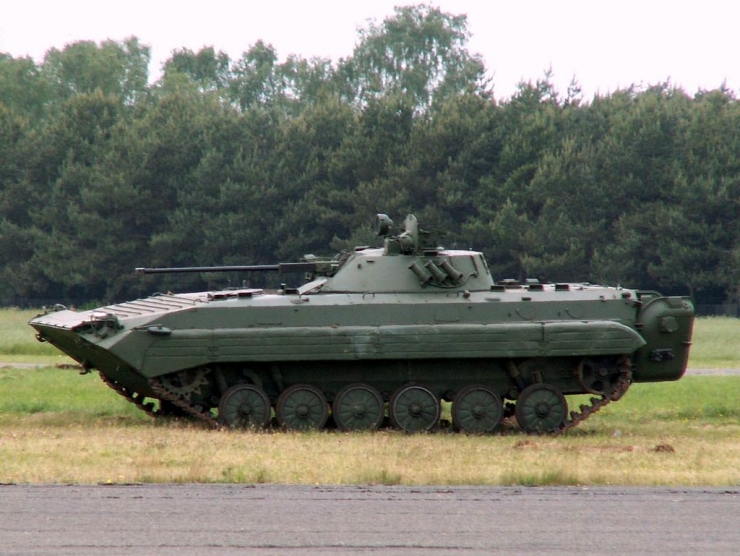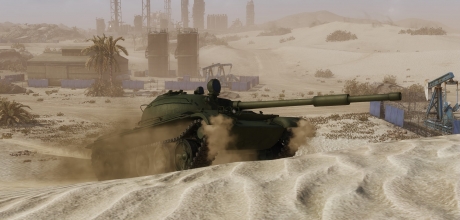After the long and arduous development, the Object 675 (as BMP-2 was known by then) finally made its way to active units in late 1970’s. In 1977, a trial series was produced at Kurganmashzavod (KMZ) and in 1979, the first army unit became equipped with the BMP-2 vehicles for a trial period, it was the 343rd Guards Tank Regiment of the 14th Guards Tank Division. The soldiers of this unit were tasked to prepare the training methods for the new vehicle and also to produce the instructors for the rest of the Soviet army.

The unit was ordered to perform a long and grueling test run – for six months, they moved from Ukraine over North Ossetia, Caucasus Mountains, Georgia and Azerbaijan all the way across the Caspian sea to Turkmenistan – and then to Alma-Ata in Kazakhstan, making their way across the Karakum desert. The test was brutal – the vehicles and crews experienced temperatures from -20 to +40 degrees and firing trials were conducted in all the possible environments including deserts, mountains and wide plains of Russia. The military convoy consisted not only of troopers – there were KMZ engineers as well, who analyzed on the spot all the issues the vehicles had and produced proposals for improvements. GBTU representatives were present as well to make sure the vehicles would be fit for duty even in extreme conditions. Even though this test method was effective, the main IFV produced in the Soviet Union was still the BMP-1 – it was only the conflict in Afghanistan that pushed the BMP-2 production forward.
The deployment of BMP-1 in Afghanistan was not very successful. The vehicle lacked proper infantry support armament and had thin armor – both of these issues caused major losses in vehicles, crews and passengers alike. Struggling to get their hands on something more suitable for its roles, the Soviet soldiers were ecstatic when first twenty BMP-2 vehicles started arriving in Afghanistan in early 1980, praising especially the high elevation angles of the gun (very useful in mountainous terrain) and its infantry support capabilities. However, just like anywhere else, when it comes to deployment and production of new military vehicles, there are always more and more delays ( especially during peacetime) – in the end, the biggest factor that sped up the production was the personal intervention of one man, army general Mikhail Mitrofanovich Zaytsev. He compiled a report and went directly to the meeting of Soviet Politburo in April, 1980. There, he loudly complained about the losses of Soviet soldiers in Afghanistan, presenting powerful arguments in favor of the new vehicle and showing the Soviet politicians a list of dead troopers, who could have lived, were they equipped with the new vehicle.
The reaction on this was immediate. In the night after the meeting, the directors of the KMZ plant (producing the BMP-2) were woken up by series of phone calls. The plant effectively switched to wartime production mode (no vacations, around-the-clock production, all the components and raw materials were preferentially delivered to KMZ) and any complaints or obstructions were considered sabotage attempts. It was under these peculiar circumstances that the production began in earnest.
Afghanistan experience
The first and immediate goal was to get as many BMP-2s to Afghanistan as possible, which actually did happen, but the vehicle was still referred to back then as “Object 675”. It took several months until the vehicle was officially accepted in Soviet service as “BMP-2” (in August 1980), an act which was confirmed by the Minister of Defense in October 1980 – by that time, dozens of vehicles were already serving in Afghanistan. During its service there, the right choice in selecting the 30mm automatic cannon was confirmed – the weapon proved to be very suitable for low-intensity conflicts (counter-insurgency warfare) and was quite effective in not only targeting flying objects (a goal it was designed for), but also in destroying groups of enemy soldiers carrying anti-tank weapons.

On the other hand, the major flaw from BMP-1 persisted: BMP-2 was very poorly armored and any armor upgrade proposals were shut down because of the demand for the vehicle to be amphibious – any more armor and the BMP-2 would not be able to swim anymore. Swimming was of course not required in a country as dry as Afghanistan, but that hardly mattered to Soviet military as a whole - the main purpose of the vehicle would still be to surge westward from the Warsaw Pact countries into Germany and there the need to cross bodies of water was very real. Naturally, the Soviet soldiers themselves, fighting for their lives in the harsh, dry land of Afghanistan pointed all these flaws out, but the only result was that local vehicle repair plants started welding or bolting additional armor plates on vehicles, cut out from the hulls of their less successful brethren. The KMZ plant itself started officially producing these “armor upgrade kits” a year later, in 1981 – the vehicles with such armor kits were designated BMP-2D and were widely used even by paratrooper forces, replacing the BMD-1 vehicles, which were even worse than BMP-1’s.
Second major issue of the BMP-2 was its vulnerability to mines. After numerous casualties of soldiers riding inside the hull the Soviet troopers started to ride actually on top of the vehicles to escape the mine blasts. To mitigate this issue the vehicles were later on given the option to mount KMT-10 mine plough devices, but it did not help much.
Despite these flaws however, the BMP-2 was praised much more than its predecessor. It was – thanks to their gun elevation – no longer safe for mujahedeens to stay on the tops of the mountains, harassing the Soviet columns with fire without having to fear any serious return fire. This issue was usually (before the arrival of the BMP-2) dealt with by using ZSU-23-4 “Shilka” AA vehicles in ground support role – the Shilkas however were very vulnerable even to small arms fire and the deployment of the BMP-2 was a significant improvement.
After the war in Afghanistan the vehicles were transferred back to the Soviet Union – but not only there, also to other “friendly” countries (to Soviet units “temporarily” stationed there of course). The public saw the BMP-2 for the first time during the military parade in Moscow on 7.11.1982 (anniversary of the Great Socialist Revolution). Later on, the vehicles were sold to other armies as well – Czechoslovakia received the first vehicles for its army in 1983 and it was produced in the Podpolianské Strojárny Detva n.p. factories between 1987 and 1989 (344 were made). India license-produced the BMP-2 from 1985 onwards under the designation of “Sarath” and other its variants (including armored ambulance, engineering vehicle and a self-propelled AA missile launcher) – it is estimated that over 1200 were made until the production was shut down. Large numbers of BMP-2 vehicles were sold also to traditional Soviet vehicle customers: Iraq, Iran, Syria, Kuwait and others. Overall, the vehicle was eventually sold to more than 30 countries.
Even after the break-up of the Soviet Union the vehicle continued to serve, proving to be a reliable, rugged and easy-to-maintain workhorse of many armies – the ease of maintenance and control being a major selling point of the armies, that have to rely heavily on conscripts. There were and still are numerous companies (including the producer itself) offering modernization programs for the BMP-2 – new engines, fire control systems and additional armor (including anti-HEAT systems).
The lessons learned in Afghanistan were largely confirmed by further use and are as valid as they were back then: a light vehicle armed with automatic cannon performs very well when used in a low-intensity conflict. Considering how the nature of warfare changed in last two decades, the BMP-2 will still have its place on the battlefield for years to come.








